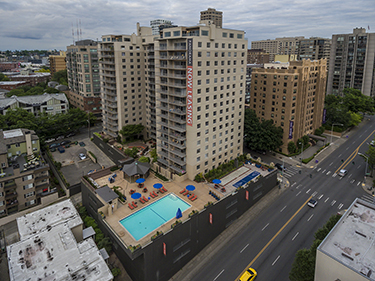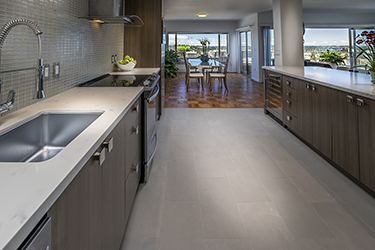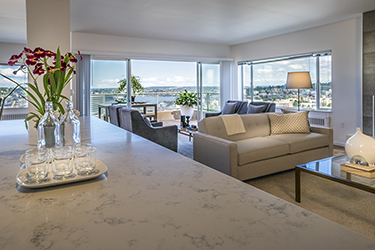|
Subscribe / Renew |
|
|
Contact Us |
|
| ► Subscribe to our Free Weekly Newsletter | |
| home | Welcome, sign in or click here to subscribe. | login |
Real Estate
| |
 |
June 23, 2016
New lease on life for iconic First Hill apartment
Security Properties

Gleason
|
The earliest media mention of First Hill’s Panorama apartment building can be traced to page 14 of the July 23, 1958, issue of The Seattle Times, in an article wedged alongside Hollywood news briefs and an ad touting Kentucky bourbon.
It details a planned $3.5 million luxury apartment tower in First Hill that would replace three turn-of-the-century mansions razed the year prior, a vestige of the neighborhood locals once referred to as “the first hill.”
Designed by prolific Seattle architect George Bolotin and originally named Panorama House for its stunning views, the building would feature a drive-in front entrance, marble lobby walls and floors, a heated outdoor pool and notably, four penthouses. The 18-story Panorama opened to residents in 1962 with monthly rent starting from $110.
In September 2014, Security Properties acquired the building, renamed it Panorama and spent more than a year completing a full-scale restoration.
The initial aim was to reapportion the large apartments into smaller ones. But it quickly became clear that maintaining the expansive floorplans — ranging from 975-square-foot one-bedroom apartments to 2,500-square-foot penthouses — would differentiate the living experience.
With new residents moving in this spring, including a few returning residents who’ve called Panorama home from the very beginning, the building is about 70 percent leased and has undergone a dramatic revitalization. Four newly restored penthouses on the 18th floor are among the largest available in any Seattle high-rise, with views oriented toward Puget Sound, Lake Union and the Cascades, and a look that melds midcentury touches with modern design.
Reimagining older buildings
A walk through the Panorama’s curved porte-cochere — a rare feature more typically found on the East Coast — is a walk through history. Originally designed to accommodate the gas guzzlers of the late 1950s and ‘60s, residents were once greeted by valets who steered the cars into an adjoining three-level parking garage. Today, the restored porte-cochere is better suited as a pick-up and drop-off location for ride-sharing services.
The trio of original columns supporting the porte-cochere and the lobby are now wrapped in a reflective stainless steel, one of the many ways in which Seattle architecture firm Clark Design Group sought to modernize the building while taking cues from Panorama’s vintage vibe.
Other examples include the lobby’s elevator bay, wrapped with original terrazzo marble, and the reclamation of original light fixtures. Even a first-floor conference table incorporates a 1,600-pound travertine slab left behind by an original penthouse resident (rumor has it that the slab was craned into the building before the roof was completed).
To architect Eli Hardi of Clark Design Group, who served as project manager on the Panorama restoration, reimagining older buildings is a balancing act. Change too much and you risk compromising the character that differentiates the property, he said.
“The porte-cochere, the terrazzo, these are all existing elements that you can’t include anymore without paying an arm and a leg. If you have it already, why not incorporate it?” he says. “From the large oculus lights in the lobby, to the penthouse skylights, to the unobstructed views from the sixth floor and up, there are a lot of unique aspects to the building that don’t exist elsewhere.”
But not everything was worth preserving.
Hardi describes the ground-floor lobby, at the time of its purchase by Security Properties, as compartmentalized and closed in. Walls separated the main amenity space from a beauty salon that once served residents. The new-look Panorama conveys the feeling of openness with expanded sightlines.
“We wanted visitors and residents to be able to stand outside the porte-cochere, look through the lobby, and be able to see through the amenity space and beyond,” Hardi said. “It’s a way to activate the ground-floor space and draw people into the building.”
Melding new with old
Not unlike the closed-in feeling of the original lobby, all 179 of the apartments once had galley-style kitchen layouts requiring a door to get in. When Clark Design Group architects first toured the units, they encountered Space Age stoves with pull-out cooktop drawers, the same sort of luxury appliance seen in ‘60s TV sitcom “Bewitched.”
Stripping away the walls allowed for an open-kitchen layout, complete with an island and built-in wine fridge. The result: a far better reflection of the kitchen’s role as a focal point and gathering place in the modern home.
“These were once closed spaces, with closed-vestibule entries, closed kitchens and closed living rooms, and you had to swim around to get that view,” said Clark Design Group associate Linda Shedd, who designed the new-look apartment interiors. “Now, you can see the view the moment you walk through the door — it’s captivating. You can’t help heading straight for the window.”
The new kitchen cabinetry, meanwhile, melds modern touches — undermount sinks and quartz countertops — with knobs inspired by the originals. Marble windowsills and marble floor thresholds are also holdovers. And the same motifs once found on the oven glass and kitchen backsplash tiles are still present throughout the building, including the window frosting in the four penthouses, and on the original staircase that connects the basement amenity floor with the lobby.
“Our guiding principle was to match the character of the original architectural elements and hardware with today’s standards, and to achieve a seamless blending of the two,” said Elisabeth Nelson, a designer with Clark Design Group.
Perhaps the most distinguishing feature found in the homes is the original parquet flooring, refinished and returned to each apartment.
Inside the four penthouses, original wood-burning fireplaces — once low to the ground and drawing attention to the bareness of the wall above — were revamped with a natural stone that was stacked vertically. In keeping with the midcentury-modern theme, it now lends a floor-to-ceiling feel, while delineating the living room from the rest of the expansive space. It’s now among the most striking features of the penthouses.
Home to modern Seattleites
Posing a few design hurdles was the building’s original electrical system, which was cast into the Panorama’s concrete framing. Adding electrical capacity to accommodate new washers and dryers in every residence — plus the demands of today’s electronics and kitchen appliances — meant devising elegant workarounds like drop ceilings to hide wires and ducts.
Much of the remaining work centered around restoring the building’s existing spaces and orienting them to modern uses.
The Panorama has long featured downtown’s largest outdoor pool deck at 15,000 square feet. In addition to refreshing the space, Security Properties replaced a tired putting green with bocce and shuffleboard courts. An outdoor kitchen, seating, fireplace and a Tiki-themed lounge have also arrived in time for summer.
“The Panorama could have been overly modernized and made bland,” Hardi says. “But pouring time into the details is what has made the project what it is. To be able to create something new from within an existing palette is that much more rewarding.”
John Gleason is the managing director of asset management for Seattle-based Security Properties, which purchased the Panorama building in 2014.
Other Stories:
- In Pioneer Square, reality replaces myth
- High rise vs. low rise — which is greener?
- Seattle’s building boom pushes apartment evolution
- Look to the water for affordable housing
- For older apartments, choose renovation over demolition
- Capturing the past in today’s buildings
- Is dead retail space bringing your building down?
- Ballard’s Nordic roots come out at Odin Apartments
- Going beyond the mock-up with virtual reality
- Re-energizing an old power plant site on Lake Washington





